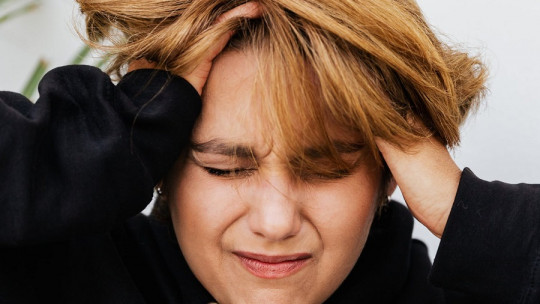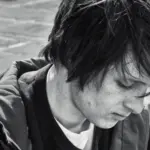
One in four people in the world suffer from a mental disorder, the most common being depressive and anxiety disorders. Its prevalence is normal, due to the high emotional burden to which we are subjected daily, with work, personal and relational pressures.
However, for the person who suffers from an anxiety or mood disorder, it can often be very difficult to detect the differences between the two, due to the similarities that can be found in their symptoms and their causes. Therefore, in this PsychologyFor article we will justify that anxiety and depression are not the same through the 7 differences between anxiety and depression. We will also look at the symptoms of both disorders and the similarities between them.
What is depression?
Depression is a mood disorder in which the person who suffers from it feels a permanent feeling of sadness, which makes them maintain a low mood and means that you stop having desire and motivation for the activities that had always stimulated him. The decline in mood produces a deterioration in the person’s personal life, thereby affecting different areas of their life, such as work or relationships.
Within mood disorders, we can find different categories of depression, such as major depression or dysthymia. However, in this article we will talk about depression as a general concept, understanding that the vast majority of depressive disorders share many symptoms.
Symptoms of depression
The symptoms of depression, as we have previously mentioned, are similar in the vast majority of depressive disorders, while in their diagnosis the temporality of their exposure must be taken into account to differentiate them. In general, the symptoms of depression are the following:
1. Psychological symptoms of depression
- Depressed mood most of the day.
- Feeling of worthlessness and/or excessive or inappropriate guilt.
- Recurrent thoughts of death, not just fear of dying, presence of recurring suicidal ideas, without a specific plan, suicide attempt or a specific plan to carry it out.
2. Physical symptoms of depression
- Sleep disturbances such as insomnia or hypersomnia.
- Weight loss or gain.
- Movements decreased, slow and without energy.
3. Behavioral symptoms of depression
- There is a significant decrease in interest or pleasure in activities that were previously enjoyed.
4. Cognitive symptoms of depression
- Decreased ability to think, concentrate and/or make decisions.
5. Social symptoms of depression
- Faced with all this set of factors, isolation occurs in personal relationships and in the environments in which one used to frequent.
What is anxiety?
Anxiety is a response that our body activates when it perceives that we are facing danger, so that it acts as a Defense mechanism in certain situations. This set of circumstances that are perceived as a danger activate emotional responses to it, which will be different depending on the situation that produces anxiety. Emotional responses awaken feelings of fear, restlessness, nervousness, avoidance behaviors to the situation and the increase in catastrophic thoughts or concerns related to it.
Anxiety is essential for survival, but when this occurs disproportionately to the real or non-existent danger it represents, it can lead to an anxiety disorder. In the following article you will find more information about anxiety.
Symptoms of anxiety
As in depression, within anxiety disorders we can find different diagnostic categories, such as simple phobia or social phobia, but in the same way as in mood disorders, this group of disorders share the presentation of many symptoms in common. In anxiety disorders, the symptomatological manifestations that occur in all disorders are physical, psychological, behavioral, intellectual or cognitive, and finally, social:
1. Psychological symptoms of anxiety
- The person feels a high fear given the situation he faces, which gives him a need for avoidance, which manifests itself with the desire to flee. You feel an irrational fear of loss of control, fear of dying, danger, uncertainty and insecurity.
2. Physical symptoms of anxiety
High physical symptoms appear in anxiety disorders. Among the physical symptoms of anxiety we find:
- Abdominal pain
- Sweating
- Tachycardia
- Need to go to the service
- Dizziness, headache
- Muscle tension
- Shortness of breath
- Increased heart rate
- Tremors
- Irritability
- Fatigue
3. Behavioral symptoms of anxiety
Anxiety activates a constant state of hypervigilance or alert and the desire to flee from feared situations. The state of alert causes behaviors to appear:
- Impulsive
- Restless
- Hyperactivity or motor agitation
- Rigidity
- Different body language
- Changes in tone of voice
- Imprecise movements.
4. Cognitive symptoms of anxiety
The anxious state in which the person finds themselves produces:
- Inattention
- Lack of concentration
- Memory difficulties
- Excessive, negative and irrational worries
5. Social symptoms of anxiety
All of the factors mentioned previously can cause a deterioration in social relationships, limiting the circumstances of the social context, due to the fear that anxiety may appear. Therefore, tendencies towards isolation, difficulties in speaking and expressing one’s own opinion and irritability tend to occur.
After seeing what depression and anxiety are, you may be wondering what the difference is between anxiety and depression. Next we will see the differences.
Differences between anxiety and depression
1. The main emotion
- In depression: the humor that appears in the person who suffers from a depressive disorder maintains a tone of sadness as the main emotion, and on rare occasions this emotion appears as an isolated form, but is maintained over time.
- In anxiety: the emotion that characterizes anxiety is fear nonspecific.
2. The cause or stimulus
Both the anxiety reaction and a depressive reaction are ways of reacting to certain internal and external stimuli.
- In depression: the event is perceived as a failure or a loss. Here you can find tips for accepting a loss.
- In anxiety: it appears in the face of a circumstantial event that has been perceived as a threat.
3. Symptoms
- In depression: the symptoms that have the greatest impact on the person’s functionality are the cognitive due to intense feelings of guilt, lack of self-esteem, alterations in appetite, feeling of exhaustion that gives off this humor and high difficulties in concentrating.
- In anxiety: physical symptoms such as tachycardia, sweating, physical pain, agitation in breathing, etc. prevails.
4. Orientation
- In depression: the person focuses in the past, in the past itself, where the person analyzes the actions of the past by undervaluing them, leaving no room for the future.
- In anxiety: fear is focused in the future facing the possible predictions that the person establishes about the near future, with the fear that those negative consequences that he perceives are going to occur will occur.
5. Variations throughout the day
- In depression: a diurnal mood variation where the person can suffer different variations in their mood during the day, in the same way as the different seasons of the year.
- In anxiety: mood variations generally do not occur.
6. Loss of interest
- In depression: one of the factors that most characterizes depression is the loss of interest, of enjoyment, of those activities that you previously liked.
- In anxiety: this loss of interest is not appreciated.
7. Activation
- In depression: there is a physical hypoactivation where the person moves slowly, fatigued.
- In anxiety: it is characterized by a hyperarousal with quick movements, in a very energetic way.
Similarities between depression and anxiety
As we have seen, depression and anxiety are not the same, however, both psychological disorders have several points in common. The similarities between anxiety and depression are the following:
1. Alterations in sleep and appetite
In both classifications the person may appear to have insomnia or hypersomnia, frequently with difficulties initiating and maintaining sleep. Appetite, although it generally tends to decrease in anxiety and increase in depression, is altered.
2. Social isolation
Both disorders have an impact on the social sphere, producing isolation, and although anxiety is caused by the fear of the appearance of physical symptoms and depression is caused by a lack of interest, energy or motivation, both promote the person’s isolation. .
3. Neurotransmitters
Biologically, the alterations that occur in our central nervous system are the same in both processes, a decrease in serotonin and norepinephrine. Therefore, pharmacologically they tend to be treated with the same drugs.
4. Treatment
As we have previously indicated, both share psychopharmacological treatment and, in addition, the psychotherapy procedures are very similar between both.
Comorbidity between anxiety and depression
The great difficulty in differentiating both diagnostic categories may be caused by the great comorbidity between the two disorders. It is very common that a person who suffers from depression may experience many feelings and symptoms of anxiety and vice versa, without knowing precisely which one precedes the other. In addition to that, many symptoms are shared in both disorders, and can manifest in any of them. The most shared explanation for the overlap of symptoms between the two manifestations tends to be attributed to comorbidity, that is, the course of the two clinical pictures at the same time because neither exempts the other.
This article is merely informative, at PsychologyFor we do not have the power to make a diagnosis or recommend a treatment. We invite you to go to a psychologist to treat your particular case.
If you want to read more articles similar to Difference between anxiety and depression we recommend that you enter our Clinical Psychology category.
Bibliography
- American Psychiatric Association. (2014). DSM-5. Diagnostic and Statistical Manual of Mental Disorders. Madrid: Editorial Médica Panamericana, SA
- Agueldo, D., Buela, G & Donald, C. (2007). Anxiety and Depression: The problem of differentiation through symptoms. Mental Health, 30, 9.
- Alarcón, R. Et al. (2003). Clinical practice guide for depressive disorders. Region of Murcia: health concierge.
- Sierra, J., Ortega, V & Zubeidat, I. (2003). Anxiety, anguish and stress: three concepts to differentiate. Malaise and subjectivity, III, 10-59.
- Gutiérrez, M. & García, M. (2000). Anxiety and cognition: an integrative framework. Spanish Journal of Motivation and Emotion (REME), 3(4).
- Espada L, FJ, & Cano-Vindel, A. (1999). Anxiety disorders and depressive disorder: Differences in the manifestations of anxious and depressive symptoms. Contemporary Psychology, 6, 30-35.
- Jiménez, M., Gálvez, N & Esteban, R. Depression and anxiety. Geriatrics treatise for residents, 23, 7.








